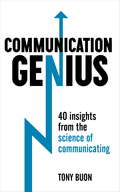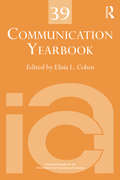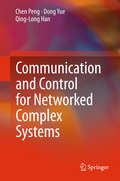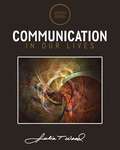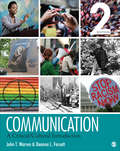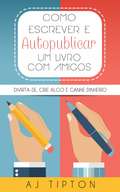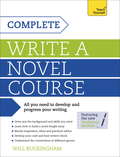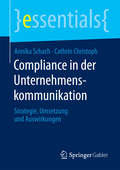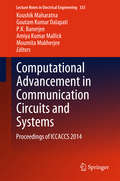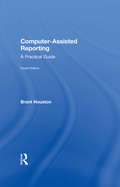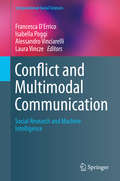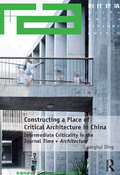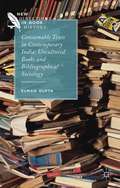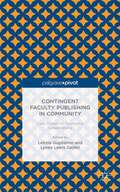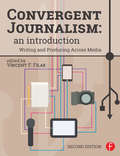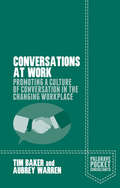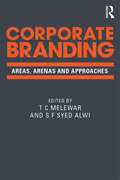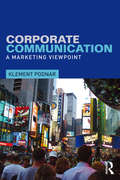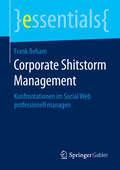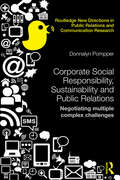- Table View
- List View
Communication Genius: 40 Insights From the Science of Communicating
by Tony BuonThe fast-track MBA in communicationImagine having instant access to the world's smartest thinking on human communication - and being shown exactly what to do to guarantee that all of your communication is right, every time. Communication Genius makes it easy to apply the scientific facts that researchers know about communication to the real world. 40 chapters based on cutting-edge business and psychology research projects reveal what works and what doesn't work when we interact with each other. Each of the 40 chapters is a mini-masterclass in communicating better, explaining the research and showing you how to apply it for yourself to improve your own communication skills.Too often, conventional wisdom says one thing while research says another. Communication Genius cuts through the noise to bring you proven research and techniques for applying it that will simply make you a better all-round communicator.With chapters on body language, emotional intelligence, neuro-linguistic programming (NLP), presentations, mimicry, groupthink and the latest neuroscience, Communication Genius explodes some myths and gives you the best that science has to offer on communication. Quick to read and intensely practical, this book will bring a little communication genius into your day.'A must read if you want to communicate better' Professor Sir Cary Cooper, Manchester Business School, University of Manchester'Required reading for anyone seeking to better their communication skills in the workplace and otherwise' Dr Anastasia P. Rush, Clinical Psychologist, CEO HELLAS EAP (Greece)'Calls into question accepted 'beliefs' (Maslow's hierarchy) and introduces the reader to an array of new theories from "IQ" racism to the Obama effect' Kate Nowlan, Chief Executive, CiC Employee Assistance, Fellow Royal Society of Arts (FRSA)'Tony has done a fantastic job in pulling together an amazing number of articles and scientific studies and making them understandable to the lay person' Andrew Kinder, Chartered Counselling & Chartered Occupational Psychologist, Employee Assistance Professionals Association (EAPA -UK) Chair
Communication Genius: 40 Insights From the Science of Communicating
by Tony BuonThe fast-track MBA in communicationImagine having instant access to the world's smartest thinking on human communication - and being shown exactly what to do to guarantee that all of your communication is right, every time. Communication Genius makes it easy to apply the scientific facts that researchers know about communication to the real world. 40 chapters based on cutting-edge business and psychology research projects reveal what works and what doesn't work when we interact with each other. Each of the 40 chapters is a mini-masterclass in communicating better, explaining the research and showing you how to apply it for yourself to improve your own communication skills.Too often, conventional wisdom says one thing while research says another. Communication Genius cuts through the noise to bring you proven research and techniques for applying it that will simply make you a better all-round communicator.With chapters on body language, emotional intelligence, neuro-linguistic programming (NLP), presentations, mimicry, groupthink and the latest neuroscience, Communication Genius explodes some myths and gives you the best that science has to offer on communication. Quick to read and intensely practical, this book will bring a little communication genius into your day.'A must read if you want to communicate better' Professor Sir Cary Cooper, Manchester Business School, University of Manchester'Required reading for anyone seeking to better their communication skills in the workplace and otherwise' Dr Anastasia P. Rush, Clinical Psychologist, CEO HELLAS EAP (Greece)'Calls into question accepted 'beliefs' (Maslow's hierarchy) and introduces the reader to an array of new theories from "IQ" racism to the Obama effect' Kate Nowlan, Chief Executive, CiC Employee Assistance, Fellow Royal Society of Arts (FRSA)'Tony has done a fantastic job in pulling together an amazing number of articles and scientific studies and making them understandable to the lay person' Andrew Kinder, Chartered Counselling & Chartered Occupational Psychologist, Employee Assistance Professionals Association (EAPA -UK) Chair
Communication Skills for Business Professionals
by Michael Lewis Phillip Cenere Robert Gill Celeste Lawson Phillip Cenere Robert Gill Celeste LawsonCommunication Skills for Business Professionals is a student-friendly introduction to the principles and practice of effective communication in the workplace. Engagingly written and full of real-life examples, it explains the key theories underpinning communication strategies and encourages students to consider how to apply them in a contemporary business environment. After working through foundation topics such as understanding the audience, persuasion and influence, negotiation and conflict management, and intercultural complexities, students will explore the various modes and contexts of workplace communication including meetings, oral communication, written reports and correspondence. The text incorporates discussion of new digital technologies such as virtual real-time communication, and dedicates an entire chapter to the specific considerations involved in writing for the web. With its emphasis on Australian contexts and examples, Communication Skills for Business Professionals is an excellent introduction to the world of professional communication.
Communication Yearbook 39
by Elisia L. CohenCommunication Yearbook 39 continues the tradition of publishing state-of-the-discipline literature reviews and essays. Editor Elisia Cohen presents a volume that is highly international and interdisciplinary in scope, with authors and chapters representing the broad global interests of the International Communication Association. The contents include summaries of communication research programs that represent the most innovative work currently. Offering a blend of chapters emphasizing timely disciplinary concerns and enduring theoretical questions, this volume will be valuable to scholars throughout communication studies
Communication and Control for Networked Complex Systems
by Chen Peng Dong Yue Qing-Long HanThis book reports on the latest advances in the study of Networked Control Systems (NCSs). It highlights novel research concepts on NCSs; the analysis and synthesis of NCSs with special attention to their networked character; self- and event-triggered communication schemes for conserving limited network resources; and communication and control co-design for improving the efficiency of NCSs. The book will be of interest to university researchers, control and network engineers, and graduate students in the control engineering, communication and network sciences interested in learning the core principles, methods, algorithms and applications of NCSs.
Communication for Behavior Change
by Esta De Fossard John RiberThe book demonstrates how to create TV and FILM DRAMAS that encourage people to make positive behavioral changes to improve their lives. The book teaches people how to: * Create SERIAL OR STAND-ALONE DRAMAS that will appeal to a select audience * Create characters that represent and attract the target audience * Introduce subtle and convincing ways to improve the standard of living of the audience * Conduct design workshops for preparing design documents that help script writers create 'convincing' dramas containing the behavior-change message accurately
Communication in Our Lives (Seventh Edition)
by Julia T. WoodProvides everything you need to strengthen your interpersonal, group, public speaking, and media literacy skills-and demonstrates the value of communication in your life.
Communication: A Critical/Cultural Introduction
by Dr Deanna L. Fassett Dr John T. WarrenCommunication: A Critical/Cultural Introduction, Second Edition introduces communication, from intimate and interpersonal to the public and mediated, as cultural. Using contemporary critical theory, authors John T. Warren and Deanna L. Fassett focus on communication as advocacy—inherently influenced by culture, history and power. By situating communication concepts and theories within contemporary and engaging cultural scenes, the book is much more than a survey of ideas—it demonstrates the power of communication in our everyday lives.
Como Escrever e Autopublicar um Livro com Amigos
by Aj Tipton Caroliny DellaparteVocê está preparado para se divertir e ganhar dinheiro autopublicando com os amigos? A escrita pode ser um trabalho difícil e solitário, se for feito sozinho. Mas não precisa ser assim. As autoras apresentam um método de autopublicação que é colaborativo e divertido. Se você está começando no mundo da autopublicação, este é o guia perfeito para você! Como Escrever e Autopublicar um Livro com Amigos é um modelo indispensável para transformar suas ideias em obras publicadas, salvando-o da frustração e solidão de tentar fazer tudo sozinho. AJ Tipton é uma equipe de escritoras bem-sucedidas e está disposta em deixar você conhecer os seus segredos, as suas lições e as dicas aprendidas sobre esse mundo cativante da escrita. Este livro inclui: + A melhor maneira de escolher o seu coautor; + Como escolher um gênero e subgênero; + Um método para criar uma história que vende; + Um guia de contratação de freelances para os trabalhos de edição, de criação da capa, de traduções, dentre outros; + Dicas de formatação e edição; + Plataformas de publicação: Amazon, Kindle Unlimited, Nook etc; + As vantagens e desvantagens de traduzir o seu livro; + Como usar o seu orçamento; + Dicas para comercializar seus livros com sucesso; + O poder das mídias sociais; + Como manter sua parceria, compartilhar tarefas e continuar a escrever juntos; E muito mais! Se você está pronto para ser criativo e escrever com os amigos, leia este guia passo a passo para iniciar sua jornada pela autopublicação agora!
Complete Write a Novel Course: Your complete guide to mastering the art of novel writing
by Will BuckinghamLEARN HOW TO WRITE A NOVEL WITH THIS COMPLETE, PRACTICAL COURSE.Designed to take you from the moment you first put pen to paper right through to the process of contacting publishers (or uploading an ebook file) and promoting your book, this is the most important book on writing that you'll ever read. It introduces you to the craft of fiction writing, the art of words and the way in which to use them. It gives you inspiration, ideas and practical advice.It gives you the background and the skills you'll need to succeed.Unlike other books on the market, however, it also helps you begin to critique your own work, meaning that at every step of the writing process you'll be producing the best art you can. There are plenty of other essential writing tools in this book, as well, including techniques for overcoming writer's block; with nearly a quarter of the book focussing on how to get published, how to publish yourself, which courses you do - and don't - need, the nuts and bolts of competitions and festivals and the importance of social media, this really is the most comprehensive companion to the subject available.ABOUT THE SERIESThe Teach Yourself Creative Writing series helps aspiring authors tell their story. Covering a range of genres from science fiction and romantic novels, to illustrated children's books and comedy, this series is packed with advice, exercises and tips for unlocking creativity and improving your writing. And because we know how daunting the blank page can be, we set up the Just Write online community at tyjustwrite, for budding authors and successful writers to connect and share.
Compliance in der Unternehmenskommunikation: Strategie, Umsetzung und Auswirkungen (essentials)
by Annika Schach Cathrin ChristophDas Essential bietet eine umfassende Einführung in die Kommunikation von Compliance aus konzeptioneller, redaktioneller und rechtlicher Perspektive. Annika Schach und Cathrin Christoph beschreiben die Maßnahmen der internen und externen Kommunikation, die notwendig sind, um alle relevanten Stakeholder zu erreichen. Darüber hinaus schildern sie die Besonderheiten bei der Verschriftlichung von Verhaltensregeln in Form eines Code of Conduct und gehen auf den Einfluss von Compliance auf die Medien- und PR-Arbeit ein - inklusive Einblick in die Praxis in Form eines Interviews mit einem der Redakteure von Europas größtem Automobilmagazin.
Computational Advancement in Communication Circuits and Systems: Proceedings of ICCACCS 2014 (Lecture Notes in Electrical Engineering #335)
by Koushik Maharatna Goutam Kumar Dalapati P. K. Banerjee Amiya Kumar Mallick Moumita MukherjeeThis book comprises the proceedings of 1st International Conference on Computational Advancement in Communication Circuits and Systems (ICCACCS 2014) organized by Narula Institute of Technology under the patronage of JIS group, affiliated to West Bengal University of Technology. The conference was supported by Technical Education Quality Improvement Program (TEQIP), New Delhi, India and had technical collaboration with IEEE Kolkata Section, along with publication partner by Springer. The book contains 62 refereed papers that aim to highlight new theoretical and experimental findings in the field of Electronics and communication engineering including interdisciplinary fields like Advanced Computing, Pattern Recognition and Analysis, Signal and Image Processing. The proceedings cover the principles, techniques and applications in microwave & devices, communication & networking, signal & image processing, and computations & mathematics & control. The proceedings reflect the conference's emphasis on strong methodological approaches and focus on applications within the domain of Computational Advancement in Communication Circuits and Systems. The content also emphasizes the emerging technologies in the Electronics and Communication field together in close examinations of practices, problems and trends.
Computer-Assisted Reporting: A Practical Guide (4th Edition)
by Brant HoustonThis straightforward and effective how-to guide provides the basics for any journalist or student beginning to use data for news stories. It has step-by-step instructions on how to do basic data analysis in journalism while addressing why these digital tools should be an integral part of reporting in the 21st century. The book pays particular attention to the need for accuracy in computer-assisted reporting and to both the potential and pitfalls in utilizing large datasets in journalism. An ideal core text for courses on data-driven journalism or computer-assisted reporting, Houston pushes back on current trends by helping current and future journalists become more accountable for the accuracy and relevance of the data they acquire and share. Online instructor's materials are available to adopting professors, and additional exercises are available free online to students at the below address: http://ire.org/carbook/username: carbookpassword: carbook4
Conflict and Multimodal Communication: Social Research and Machine Intelligence (Computational Social Sciences)
by Francesca D'Errico Isabella Poggi Alessandro Vinciarelli Laura VinczeThis book explores the use of technology to detect, predict and understand social cues, in order to analyze and prevent conflict. Traditional human sciences approaches are enriched with the latest developments in Social Signal Processing aimed at an automatic understanding of conflict and negotiation. Communication--both verbal and non-verbal, within the context of a conflict--is studied with the aim of promoting the use of intelligent machines that automatically measure and understand the escalation of conflict, and are able to manage it, in order to support the negotiation process. Particular attention is paid to the integration of human sciences findings with computational approaches, from the application of correct methodologies for the collection of valid data to the development of computational approaches inspired by research on verbal and multimodal communication. In the words of the trade unionist Pierre Carniti, "We should reevaluate conflict, since without conflict there is no social justice. " With this in mind, this volume does not approach conflict simply as an obstacle to be overcome, but as a concept to be fully analyzed. The philosophical, linguistic and psychological aspects of conflict, once understood, can be used to promote conflict management as a means for change and social justice.
Connect to Your Career
by Julie Jaehne Suzann ConnellConnect to Your Career presents a nontraditional approach to the career-search process. Focusing on proven strategies that use technology as a tool, students will learn how to use the Internet to navigate through the myriad of career opportunities that await them. * Establish social media accounts to create an online identity and learn how to protect it. * Create a personal portfolio to use while exploring career opportunities. * Build a personal brand. * Design an infographic resume that will capture the eye of employers. * Implement a Sunday Evening Plan to help stay on top of career opportunities. * Prepare to take certification exams by answering practice questions. * Develop a professional network as support in the job-search process. * Apply for jobs online and in-person while managing career-search activities.
Constructing a Place of Critical Architecture in China: Intermediate Criticality in the Journal Time + Architecture
by Guanghui DingFor the past 30 years, The Chinese journal Time + Architecture (Shidai Jianzhu) has focused on publishing innovative and exploratory work by emerging architects based in private design firms who were committed to new material, theoretical and pedagogical practices. In doing so, this book argues that the journal has engaged in the presentation and production of a particular form of critical architecture - described as an ’intermediate criticality’ - as a response to the particular constraints of the Chinese cultural and political context. The journal’s publications displayed a ’dual critique’ - a resistant attitude to the dominant modes of commercial building practice, characterised by rapid and large-scale urban expansion, and an alternative publishing practice focusing on emerging, independent architectural practitioners through the active integration of theoretical debates, architectural projects, and criticisms. This dual critique is illustrated through a careful review and analysis of the history and programme of the journal. By showing how the work of emerging architects, including Yung Ho Chang, Wang Shu, Liu Jiakun and Urbanus, are situated within the context of the journal’s special thematic editions on experimental architecture, exhibition, group design, new urban space and professional system, the book assesses the contribution the journal has made to the emergence of a critical architecture in China, in the context of how it was articulated, debated, presented and perhaps even ’produced’ within the pages of the publication itself. The protagonists of critical architecture have endeavoured to construct an alternative mode of form and space with strong aesthetic and socio-political implications to the predominant production of architecture under the current Chinese socialist market economy. To rebel against certain forms of domination and suppression by capital and power is by no means to completely reject them; rather, it is to use thos
Consumable Texts in Contemporary India
by Suman GuptaThrough what he terms "bibliographical sociology," Suman Gupta explores the presence of English-language publications in the contemporary Indian context their productions, circulations and readerships to understand current social trends. "
Contingent Faculty Publishing in Community: Case Studies for Successful Collaborations
by Lynée Lewis Gaillet Letizia GuglielmoContributors argue that the key to innovative teaching and scholarship lies in institutional support for the contingent labor force, and they encourage contingent faculty to organize self-mentoring groups, create venues for learning/disseminating their experiences and findings, and connect scholarship to service and teaching in novel ways.
Convergent Journalism: Writing and Producing Across Media
by Vincent F. FilakConvergent Journalism: An Introduction is a pioneering textbook that will teach you how to master the skills needed to be a journalist in today's converged media landscape. This book shows you what makes a news story effective, and how to identify the best platform for a particular story, whether it's the Web, broadcast or print. The bedrock tenets of journalism remain at the core of this book, including information dissemination, storytelling, audience engagement. After establishing these journalism basics, the book goes into great detail on how to tailor a story to meet the needs of various media. Vincent F. Filak has brought this second edition completely up to date through: A thorough reorganization of the chapters, which provides a newer, more practical approach focused on "how to do convergent journalism," rather than simply observing the current state of converged media. A number of new pedagogical features to improve learning and retention, including examples, exercises, breakout boxes and more. Coverage of additional topics such as issues of law and ethics in digital media, and also writing for mobile platforms and social media. A companion website with links to additional examples of quality text, images and multimedia for students, as well as an instructor site with a test bank, suggested exercises and discussion questions.
Conversations at Work: Promoting a Culture of Conversation in the Changing Workplace (Palgrave Pocket Consultants)
by Tim Baker Aubrey WarrenOrganizations are about conversations. For any organization to achieve its goals, people need to interact and those interactions require dialogue and conversation. Yet, thanks to technology, we seem to be having fewer genuine conversations. This book seeks to change this, through "how to skills" and wider cultural change advice.
Corporate Branding: Areas, arenas and approaches
by T C Melewar S F AlwiA strong corporate image has power in a competitive marketplace. Its influence on reputational value and customer decision-making is only now beginning to be understood. Interest in corporate branding is exploding as marketing academics and professionals begin to realize how it can boost business performance in measurable ways. For example, it promotes customer patronage without expensive advertising and raises profitability by enabling companies to leverage their brand image when buying from particular sources. Yet there are few empirical studies available to clarify its basic tenets and fewer still that help us understand corporate branding in different parts of the world. Existing books focus mainly on conceptual ideas and real-life examples. Corporate Branding: Areas, arenas and approaches is a unique take on corporate branding that provides a global overview through rigorous research of different geographical areas across industries. An international range of leading scholars contribute their coverage across three clear themes: Area: geographical areas across the globe including the UK, USA, Europe and Asia;Arena: a variety of commercial and not-for-profit sectors, both B2B and B2C;Approach: methodological approaches to brand research design, including qualitative, quantitative, case studies, interpretivistic and social narrative. These three themes enable the reader to consider corporate branding from more perspectives and in more ways than any other corporate branding book. The result is an understanding of this strategically important, growing subject that cannot be found anywhere else. This book is an essential read for any branding student or interested professional.
Corporate Communication: A Marketing Viewpoint
by Klement PodnarCorporate Communication: A Marketing Viewpoint offers an overview of the framework, key concepts, strategies and techniques from a unique marketing perspective. While other textbooks are limited to a managerial or PR perspective, this book provides a complete, holistic overview of the many ways communication can add value to an organization. Step by step, this text introduces the main concepts of the field, including discipline and function frameworks, corporate identity, corporate and employer branding, corporate social responsibility, stakeholder management, storytelling, corporate associations, identification, commitment and acceptability. In order to help reinforce key learning points, grasp the essential facts and digest and retain information, the text offers a comprehensive pedagogy, including: chapter summaries; a list of key words and concepts; case studies and questions at the end of each chapter. Principles are illustrated through a wealth of real life examples, drawn from a variety of big, small, global and local companies such as BMW Group, Hidria, Lego, Mercator, Krka, Barilla, Domino's Pizza, Gorenje, Si Mobil, BP, Harley-Davidson and Coca-Cola. This exciting new textbook is essential reading for all professional corporate marketing and communication executives, as well as undergraduate and postgraduate students of marketing and public relations, not to mention managers who need a complete and accurate view of this increasingly important subject.
Corporate Shitstorm Management: Konfrontationen im Social Web professionell managen (essentials)
by Frank BehamDas Essential vermittelt in kompakter Form Handlungsempfehlungen für Unternehmen, die mit einem Shitstorm konfrontiert sind. Auf der Basis einer Untersuchung von sieben Shitstorms stellt Frank Beham wirksame Maßnahmen zur frühzeitigen Erkennung eines Shitstorms vor und steckt einen Handlungsrahmen zur adäquaten Reaktion ab. Darüber hinaus wird der Leser befähigt, das Gefährdungspotenzial und die Konsequenzen eines Shitstorms abzuschätzen. Dieses Buch kann jedem Unternehmen nutzen, das im Social Web präsent ist, und gibt wertvolle Hinweise, wie zukünftige Konfrontationen professionell bewältigt werden können.
Corporate Social Responsibility, Sustainability and Public Relations: Negotiating Multiple Complex Challenges (Routledge New Directions in PR & Communication Research)
by Donnalyn PompperWhile public relations offers numerous assets for organization-stakeholder relationship building and for ethical corporate social responsibility and sustainability communication, it also faces challenges linked to negative perceptions of the profession which can lead to accusations of "greenwashing." This innovative book critically explores the growing, complex and sometimes contradictory connections among public relations, corporate social responsibility and sustainability. This book advocates a postmodern insider-activist role for public relations which can transform organizations into moral places committed to people, planet, and profit. By amplifying voices of nearly 100 for-profit and nonprofit professionals, and using hermeneutic phenomenological theme analyses of CSR/Sustainability reports and websites, this book invokes public relations, postmodern and critical theories to empower public relations professionals to transform organizations into ethical, authentic and transparent actors in the public sphere. It is essential reading for scholars, educators and enquiring professionals working in public relations, corporate communication, sustainability and corporate social responsibility.
Corpus-Based Studies of Translational Chinese in English-Chinese Translation (New Frontiers in Translation Studies)
by Richard Xiao Xianyao HuThis book takes a corpus-based approach, which integrates translation studies and contrastive analysis, to the study of translational language. It presents the world's first balanced corpus of translational Chinese, which, in combination with a comparable native Chinese corpus, provides a reliable empirical basis for a comprehensive account of the macro-statistic, lexical, and grammatical features of translational Chinese in English-to-Chinese translation - a significant contribution to Descriptive Translation Studies. The research findings based on these two distinctly different languages have important implications for universal translation research on the European tradition.
